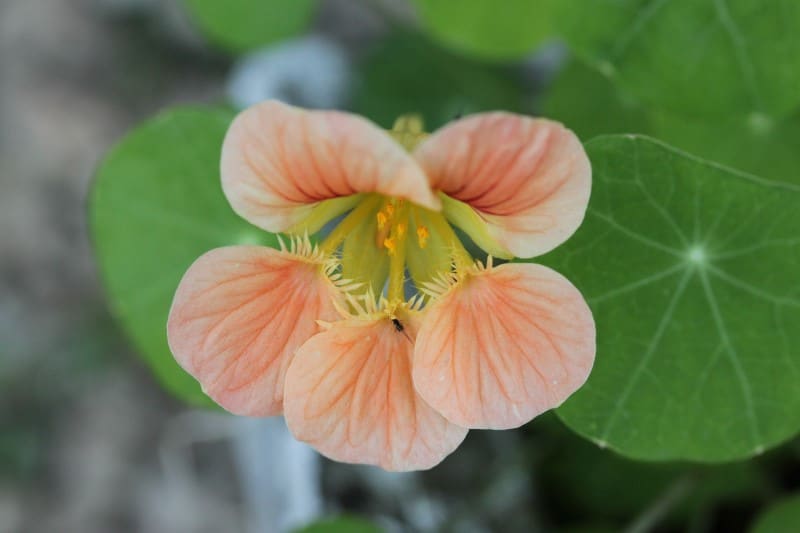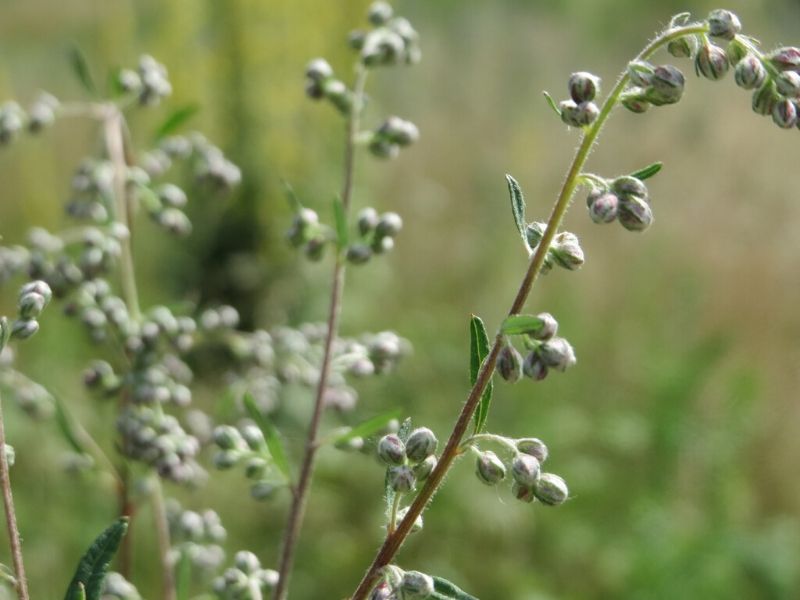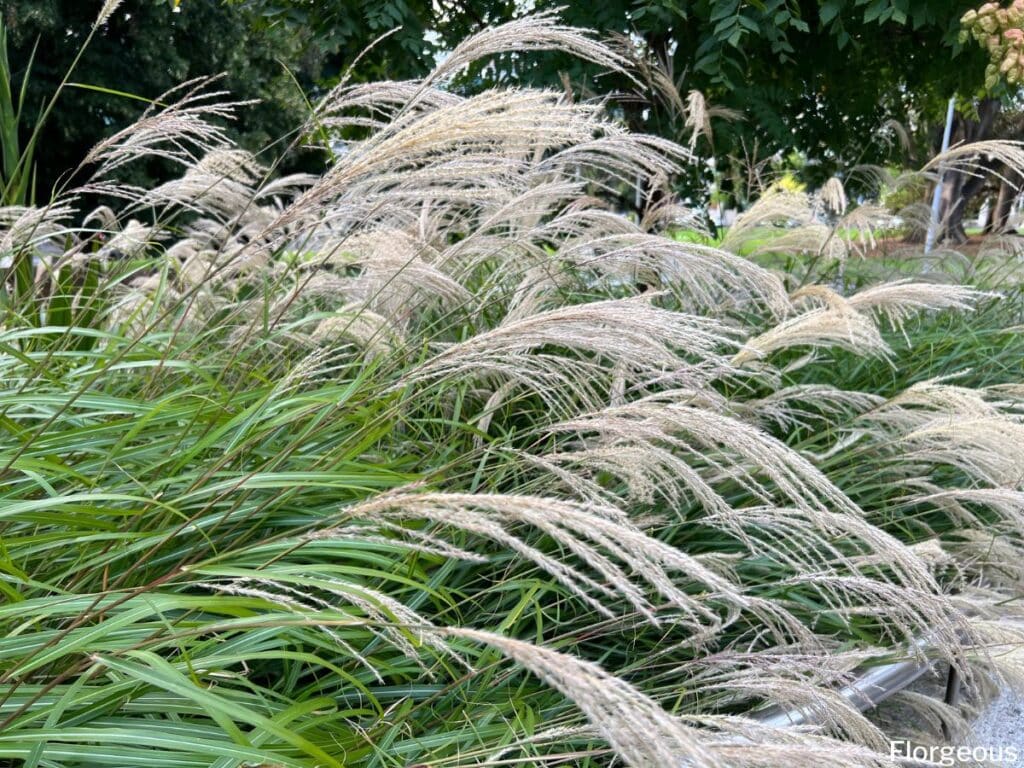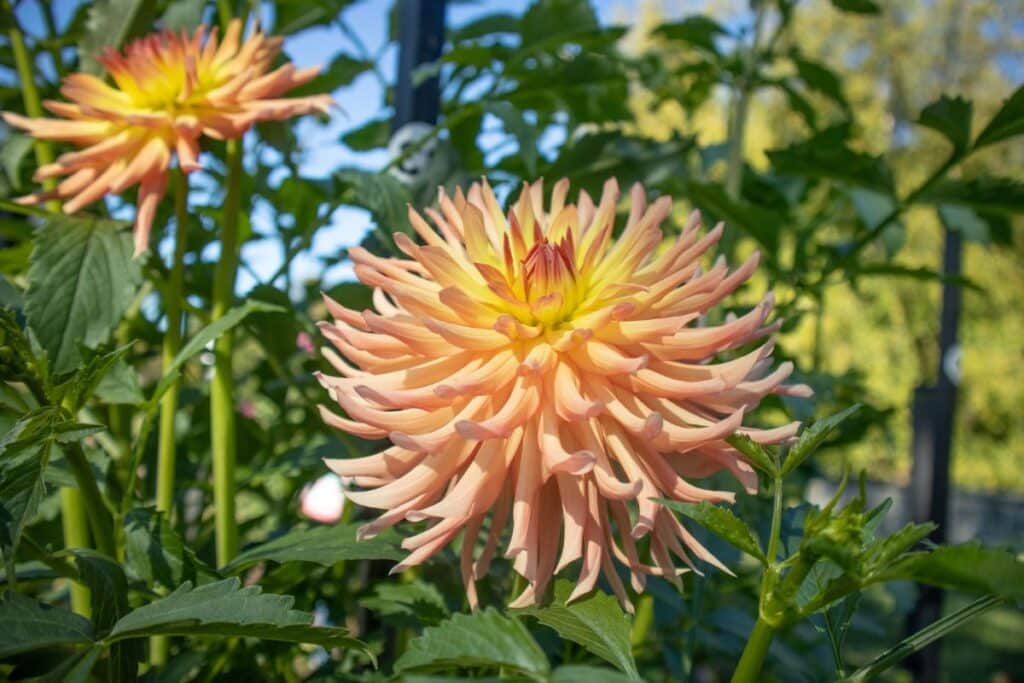Dahlias (Dahlia pinnata) are some of the most interesting flowering plants that you can include in your garden. These charming plants produce vivid flowers with a very unique leaf pattern and the large flower heads are light and airy. There are many different varieties and the colorful flowers come in many different hues.
These cheerful blooms look charming all on their own. They will, however, look especially attractive if you pair them with companion plants like nasturtiums, artemisia flowers, ornamental grasses, creeping comfrey, bee balm, lavender, mugwort, and many floral species.
Let’s take a closer look at these great companion plants for dahlias and discuss the best ways to pair them in your garden.
What to Plant with Dahlias
While you are seeking the best dahlia companions, you should first consider the growing requirement for these flowers by learning where and how to grow dahlias.
Dahlias grow well in warm conditions and they need to be positioned in a sunny site so they will develop lots of beautiful blooms.
It is best to plant these sun-loving perennial flowers in well-drained soil and they will flourish with regular watering from drip irrigation since the plant isn’t too fond of water on its leaves. These plants are also not too fond of garden pots but will grow in containers in the right conditions.
Let’s take a look at companion plants that can grow well in these sunny and hot conditions.
Nasturtiums

Nasturtiums (Tropaeolum) are excellent dahlia companion plants because they act as a ground cover to keep the soil around your dahlias nice and moist.
These edible plants also produce lots of showy flowers in colors like yellow and orange that can look striking if paired with other warm-toned flowers. They will also protect your dahlias from common pests because it acts as a sacrificial plant and will lure pests like cucumber beetles and aphids away from your dahlias.
Nasturtiums will tolerate shade but they grow their best in a full-sun position. They can grow in moist soil but prefer free-draining soil with lots of nutrients. The annuals prefer weekly watering but can be watered more often.
The best way to pair nasturtiums with dahlia flowers is by growing these vine-like shrubs in the front of your garden bed. You can also trail them up behind dahlias to create a striking backdrop.
It is best to leave a little bit of room between nasturtiums and dahlias so you can easily clear away these plants if they become too infested with pests.
Artemisia

Artemisia (Artemisia vulgaris), also known as common mugwort or wormwood, is a charming companion plant to include if you are looking for a texture-rich filler plant. There are many different species of mugwort and they vary quite a bit in foliage color. Some also produce tiny yellow flowers that can look charming in your dahlia bed.
Many gardeners include wormwood in their gardens because this herbaceous plant can repel pests. The strong fragrance of the foliage tends to repel slugs, caterpillars, white flies, and aphids.
These plants with their silver foliage prefer a full sun location but they can also handle partial shade. They grow well in dry to moist soil conditions but prefer soil that drains well and they have good drought tolerance.
These shrubs can grow up to 3 feet tall while dahlias can grow up to 6 feet tall. When you are pairing different species, you should be careful to position the taller plants in the back. It is also best to scatter mugwort about in your mixed bed so the powerful scent can keep pests away.
Ornamental Grasses

Ornamental grass can also be great companion plants for dahlias because it will add lots of texture with its tall leaf blades and soft flowers.
Most ornamental grasses grow very well in an open full sun position with well-drained soil but some varieties might need to be watered a little bit more frequently compared to dahlias.
You can pair all sorts of ornamental grass varieties like Pampas grass (Cortaderia selloana), Foxtail barley (Hordeum jubatum), Fountain grass (Pennisetum alopecuroides), Purple fountain grass (Pennisetum setaceum), or Mexican feather grass (Stipa tenuissima) with dahlias because all of these varieties are terrific for adding lots of fine texture and color to your garden.
Ornamental grass can be planted next to dahlias or you can grow tall varieties of grass behind your dahlias. You can also plant ornamental grasses in large containers and place them randomly amongst your dahlias for an interesting and showy effect.
Creeping Comfrey
Creeping comfrey (Clarika rostrata) is another interesting companion to grow with dahlia plants because it is great for filling out your garden and for adding color and texture. The scent of this plant can also help repel pests like slugs and japanese beetles.
This plant will grow well in full sun to dappled shade areas and it should be grown in well-drained soil. As with dahlias, they will die back during the colder months and re-emerge every spring.
These plants are useful as ground cover or border plants because they are shorter than dahlias and they can grow rather dense.
Bee Balm

Bee balm (Monarda) will look charming alongside your dahlia plants because they also produce colorful blooms with interesting flower designs from mid-summer to late summer.
These hardy plants can grow in full sun or partial shade but won’t produce as many flowers in shade areas. The plants can be susceptible to powdery mildew which means you need to be careful to establish it in well-drained soil.
You can mix these colorful flowers all over your dahlia bed but keep them positioned toward the front of your garden because they can be a little bit shorter with a maximum height of 4 feet tall depending on the variety.
Sweet Alyssum
Sweet alyssum (Lobularia maritima) is another good companion for dahlias because the fragrant flowers will attract butterflies, bees, and other beneficial insects like predatory wasps and ladybugs to your garden. Some of these insects are great for adding life and charm to your garden while others like wasps or ladybugs can repel pests by feeding on these insects.
Alyssum plants prefer full sun but can be grown in partial shade. They are drought tolerant and require moderate watering but should be established in free-draining soil with lots of compost but very little nitrogen.
Because sweet alyssum is shorter with a height of just 3 to 9 inches tall, it is usually best to grow this good companion plant in the front part of your garden.
Coastal Lavender
Coastal lavender (Limonium vulgare), also known as sea lavender, are great companion plants for dahlias because the foliage of this plant stays relatively short at a height of about 18 inches but it produces flowers on much taller stalks. This combination of plants will keep the base of your garden nice and full while offering lots of showy flowers that look striking alongside dahlias.
Coastal lavender is salt, moisture, and drought tolerant. The plants prefer warm and dry conditions and should flourish alongside dahlias.
It is best to position coastal lavender toward the front of your garden bed. this way the lavender foliage will keep your garden full and conceal the dead leaves of dahlias when they start to die back for the colder season.
What NOT to Grow with Dahlias
Dahlias don’t like too much moisture and won’t flower properly if you plant them in the shade. You should avoid planting them with shade and moisture-dependent plants like Japanese forest grass, ferns, begonias, and hostas because these plants will wilt and scorch in the hot and sunny areas that dahlias grow in.
It is also best to avoid growing taller plants and shrubs in front of your dahlias because this will make it hard to spot the beautiful blooms.
Don’t pair dahlias with trees or tall shrubs. The taller plants can deprive these flowers of sunlight and will prevent them from developing lots of beautiful flowers.
Landscaping ideas for Dahlia Companions
Now that you know more about great companion plants to include in your dahlia garden, it is time to explore different ways to pair these plants. Here are some clever landscaping ideas for a striking dahlia bed.
Next to a Picket Fence
Dahlias are taller plants but the base or stems of these plants can sometimes look a bit bleak or empty. A great way to enhance their beauty, add some structure to your garden, and cover up their stems is by growing them next to a picket fence. They look charming as they peek out above picked fences and you can pair them with other tall flowers like cosmos flowers, ornamental grasses, or bee balm so you can have a large display of colorful blooms.
In Front of Homes or Walls
Tall flowering plants can be wonderful for concealing unsightly areas in your garden. They are also practical in front of your garden wall or in front of your home wall. For this type of setup, it is usually best to position the taller plants in the back with shorter ornamental varieties like nasturtium or coastal lavender in the front to conceal the base of these flowers.
In Dry Gardens
Dahlias are great additions if you want to create a dry garden scape, a water-efficient garden, or if you want to add some color to your xeriscape garden. The flowers are drought tolerant and will grow well amongst rocky features and other plants that love open spaces like ornamental grasses. These and other drought-tolerant flowers are great for creating a wildflower effect.
Final Thoughts
Dahlias will grow very well alongside many ornamental plants like fountain grass, lavender, nasturtiums, alyssum, bee balm, creeping comfrey, artemisia, and many other plants. We hope that this guide helped you find some great companion plants so you can get rid of unwanted pests or create beautiful garden spaces.
Finally, don’t forget to learn more about dahlia symbolism to understand why people love growing this flower.
*image by wirestock_creators/depositphotos







